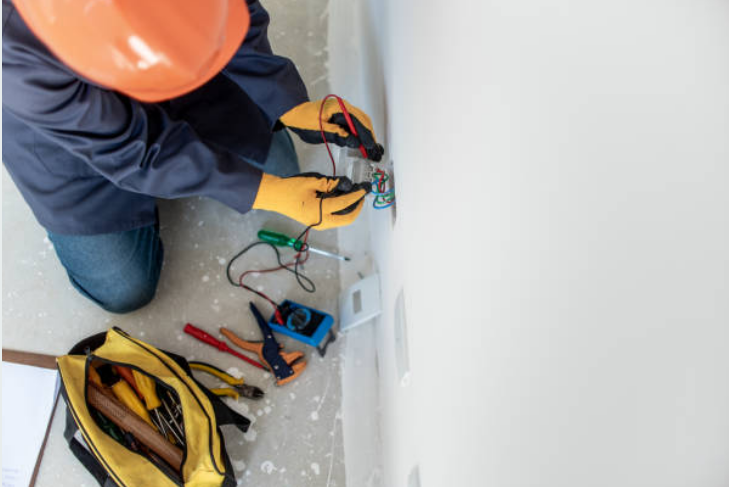Electric Meter Box Installations and Upgrades
by siteadmin

Your electric meter box is an important part of your home. If you have frequent circuit breaker tripping, scorch marks and burns on your equipment it may be time to replace your meter box. Replacing exterior cables can be expensive, up to $1,500 for overhead lines and $5,000 or more if the cable is underground. It also requires shutting off your power.
If you are looking for a reliable electrician in Fort Lauderdale, look no further than Ampi Electric Inc., as we have an Electrician Fort Lauderdale residents can trust. We understand that an electrical system is the most important part of your home or commercial building, considering it provides power to do necessary tasks everyday. That’s why we’re dedicated to providing the best possible electrician services in Fort Lauderdale, whether it’s for repairs, installations, or maintenance.
Our Electrician Fort Lauderdale team of experienced and certified electricians are always available to help you with any electrical issue you may have, no matter the size. We’re also proud to offer a 100% satisfaction guarantee on all of our work, so you can be sure you’re making the best decision for your property.
Overhead Electric Cable
Overhead electric cable is the wire that runs from the pole to your house. It usually carries three wires, but sometimes only two (a neutral and a hot). The cables are typically rated for up to 600 volts. They are made of 1350-H19 aluminum alloy and have a cross-linked polyethylene XLPE insulation that provides protection against the risks found outdoors. This insulation is resistant to moisture, various chemicals, and temperatures.
Overhead wires must be carefully inspected regularly, and if they become damaged or have an unbalanced load, it’s important to call a licensed electrician to make repairs right away. This prevents dangerous voltage spikes from affecting electrical equipment. In addition, a frayed cable near the electric meter can create a potential fire risk.
Many homes have a 100 amp service panel, but as energy demands increase it’s becoming common for homeowners to upgrade their panels to 200 amps. This requires changing the service entrance cable, a new meter base and installing a 200 amp meter socket.
The cost of a 200 amp upgrade can vary, depending on how much work needs to be done. A basic project costs about $1,500 for overhead lines, but may run up to $5,000 or more if the wires are underground.
To install a 200 amp service panel, the electrician first needs to disconnect the power to the existing meter and meter base. They then need to enlarge the existing cable hole and bore through the rim joist. A PVC weather head and conduit are then installed. Once the new meter base is in place, a 200 amp breaker can be connected to the existing circuit breakers.
When working on overhead electric lines, the electrician must keep a specified safe distance from it. The safe distance is determined by the type of work being carried out. For example, when a tag is red with a green insert, this means that the wires are live and work must be completed within the minimum approach distance. This includes when workers are using ladders, cranes or tip trucks, irrigation booms or any other equipment that can be raised and lowered.
Weatherhead
The weatherhead is the point where the overhead wires transition to an insulated cable that brings power into your house. It’s a rounded cap that sits atop the service mast, through which the power lines turn downward toward your electrical meter. The weatherhead protects the wires from dirt, insects, and rainwater that can infiltrate the mast. Without it, the wiring could get wet and short out.
A weatherhead is also referred to as a “weathercap,” “service head,” or “service entrance cap.” It’s an essential piece of equipment that ensures you have a working electrical system and protects the entrance cables from the elements. The weatherhead is shaped like a hood and has one side that slopes down, which allows precipitation to flow away from the connection. The bottom of the hood is covered in rubberized gaskets that keep water out and debris from entering.
While it may be tempting to replace a weatherhead yourself, this is not something you want to try at home. The wires that run through the weatherhead carry high voltage and are dangerous to touch. Plus, local code requires the installer to obtain a permit and have the work inspected.
If your weatherhead is leaking, or the cable that connects it to your house has been cut, you should contact an electrician immediately. You need a licensed electrician to inspect the entire service entry point which includes the weatherhead, meter mast and drip loops, and repair or replace it as necessary.
An electrician will install a new meter socket, a PVC weatherhead and conduit, and copper ground rods. They’ll also mark where underground lines are; bore through the rim joist and bury the conduit. Once the meter box and conduit are in place, they’ll connect the incoming electricity and the existing wires that connect to your meter box with Vectren. Finally, the electrician will install the meter and test the system. The meter will show how much electricity your household is using and the utility company will bill you accordingly. This process can take up to a week.
Meter Base
The meter base is the unit that holds your electricity meter. The meter measures how much electricity is flowing from the utility companies wires to your home, and it is responsible for transmitting that information back to the company so they know how much to charge you. It is also responsible for distributing power to your house, so it is essential that it is in good working condition.
There are a number of different types of electric meter bases. Some are older and some are newer, but they all serve the same purpose. The newest ones are typically made of aluminum and designed for optimal performance and durability. They are also more attractive than their older counterparts and come in a variety of styles to suit your homes exterior. Older meter bases are usually made of steel and can be quite heavy. They are also more susceptible to damage due to the weather and other environmental factors.
If the meter base is damaged, it can pose a significant safety risk. If the connections become loose, it can cause arcing or short circuits, which can lead to fires and injuries. It is essential to have the meter base repaired and maintained by an experienced electrician.
A professional can replace your meter base quickly and easily, ensuring that it is in good working condition. They can also install a new electrical panel or upgrade your existing one. The cost of a new meter base is generally less than it would be to replace the entire panel.
The meter socket mounted hardware shall be installed into brick, concrete block or a wooden stud backing. If the meter socket is mounted on a Customer’s pole or support structure, approval for such installation must be obtained from the Division Office.
The wiring between the meter socket and the main breaker is the responsibility of the Customer. It is recommended that an oxidation inhibitor be applied to all copper conductors prior to being placed in the meter socket terminals. It is also recommended that a protective cover be used on all covers that are attached by screws or bolts.
Wiring
The cable that leads from the Weatherhead to the electric meter is known as the service wire. This is a homeowners responsibility and if it gets damaged or worn out, it should be replaced immediately by a certified professional. When the service wire is faulty, it can cause high voltage issues that can damage electronics or even start an electrical fire. This is why it is important to call an electrician to perform any electrical work in the area of the meter base.
Meter sockets (also called meter cabinets or instrument-transformer cabinets) are designed to have a lifespan of over 30 years, but they can fail due to corroded interior wiring, environmental contaminants, excessive electrical loads, frequent changing of meters, or vandalism. When a meter socket is corroded, it is recommended that it be replaced by a new one, rather than attempting to fix the old one.
An electrician will open the meter cabinet, which is usually located outside the home, to inspect the wiring. Then, they will shut off the power to the meter. Once the meter is shut off, the technician will bring the two hot feed wires down from the overhead mast or through an underground feed into the meter box. The technician will connect the ends of these wires to their corresponding load terminals on the meter’s hot bus bars. They will then tighten the screws and tug on the wires to ensure that they are secure.
Once the hot side of the meter is connected, the technician will then run a grounding wire from the center terminal on the meter to the grounding rod that is buried in the ground. This will complete the system of grounding and protecting against lightning strikes, electric shocks, or arcing faults.
It is very important to keep in mind that the meter box itself should not be touched by anyone except a utility representative. Attempting to remove or install a meter base without the proper training and equipment can result in serious injuries or death. For this reason, any meter box replacement should be left to a licensed electrician. A licensed electrician west palm beach is required to possess a number of key skills and competencies. These include a strong understanding of electrical systems and safety protocols, excellent problem-solving skills, and the ability to work well with others on job sites. In addition, a commitment to continuing education and training is essential for those seeking to enter this career. Florida’s best schools for electrician training design curricula that meet the industry standards and provide students with the tools they need to succeed.
Your electric meter box is an important part of your home. If you have frequent circuit breaker tripping, scorch marks and burns on your equipment it may be time to replace your meter box. Replacing exterior cables can be expensive, up to $1,500 for overhead lines and $5,000 or more if the cable is underground.…
Recent Posts
- Best Electrician Huntsville: Your Trusted 24/7 Electrician in Huntsville, AL
- Best Electrician Huntsville: Your Trusted 24/7 Electrician in Huntsville, AL
- Harnessing the Sun: The Rise of Solar Companies in El Paso
- Eco-Friendly Power: How Solar Panels Are Changing the Game in NT
- Eco-Friendly Power: How Solar Panels Are Changing the Game in NT
